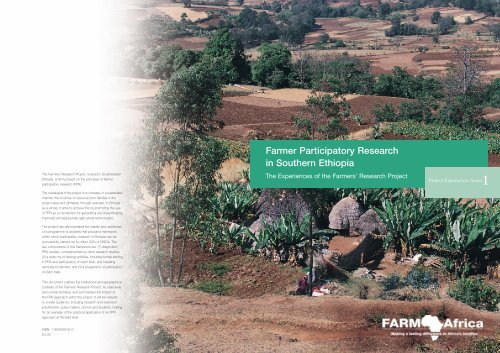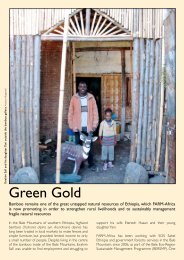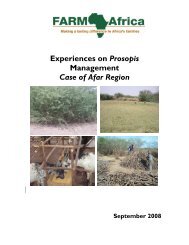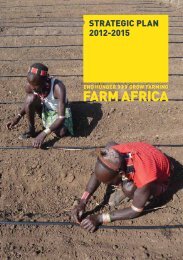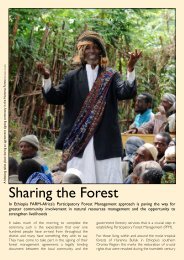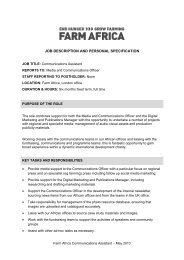Farmer Participatory Research Ethiopia.pdf - Farm Africa
Farmer Participatory Research Ethiopia.pdf - Farm Africa
Farmer Participatory Research Ethiopia.pdf - Farm Africa
- No tags were found...
You also want an ePaper? Increase the reach of your titles
YUMPU automatically turns print PDFs into web optimized ePapers that Google loves.
The <strong><strong>Farm</strong>er</strong>s' <strong>Research</strong> Project, located in Southwestern<strong>Ethiopia</strong>, is firmly based on the principles of farmerparticipatory research (FPR).<strong><strong>Farm</strong>er</strong> <strong>Participatory</strong> <strong>Research</strong>in Southern <strong>Ethiopia</strong>The Experiences of the <strong><strong>Farm</strong>er</strong>s’ <strong>Research</strong> ProjectProject Experiences Series1The overall goal of the project is to increase, in a sustainablemanner, the incomes of resource poor families in theproject area and ultimately, through example, in <strong>Ethiopia</strong>as a whole. It aims to achieve this by promoting the useof FPR as a mechanism for generating and disseminatingimproved and appropriate agricultural technologies.The project has demonstrated the viability and usefulnessof a programme of activities that provide a frameworkwithin which participatory research in <strong>Ethiopia</strong> can besuccessfully carried out by either GOs or NGOs. Thekey components of this framework are: (1) diagnostic/PRA studies, complemented by other research studies;(2) a wide mix of training activities, including formal trainingin PRA and participatory on-farm trials, and travellingseminars for farmers; and (3) a programme of participatoryon-farm trials.This document outlines the institutional and geographicalcontexts of the <strong><strong>Farm</strong>er</strong>s' <strong>Research</strong> Project, its objectivesand central activities, and summarises the impact ofthe FPR approach within the project. It will be relevantto a wide audience, including research and extensionpractitioners, policy makers, donors and students, lookingfor an example of the practical application of an FPRapproach at the field level.ISBN 1-904029-00-0£4.00
FARM (Food and Agricultural <strong>Research</strong> Management) isa British based NGO whose goal is to reduce poverty byenabling marginal <strong>Africa</strong>n farmers and herders to makesustainable improvements to their well-being throughmore effective management of their renewable naturalresources.FARM-<strong>Africa</strong> seeks to achieve its mission by working inthe following manner:Innovative, challenging and risk-takingSpecialisedPractical and operationalCatalytic, rather than merely providing servicesIndependentActing as a bridge between researchers and farmersBuilding the capacity of people and local institutionsin <strong>Africa</strong> rather than developing parallel structuresDisseminating practical experienceAdvocacy to improve policy and practiceConducting research, when required, that is relevantto practical problems confronting communities<strong><strong>Farm</strong>er</strong> <strong>Participatory</strong> <strong>Research</strong> inSouthern <strong>Ethiopia</strong>The Experiences of the <strong><strong>Farm</strong>er</strong>s’ <strong>Research</strong> ProjectFARM-<strong>Africa</strong>9-10 Southampton PlaceLondon WC1A 2EATel: UK 020 7430 0440farmafrica@farmafrica.org.uk
Glossary1 IntroductionBOABureau of AgricultureFARMFood and Agricultural <strong>Research</strong> ManagementFPR<strong><strong>Farm</strong>er</strong> <strong>Participatory</strong> <strong>Research</strong>FRP<strong><strong>Farm</strong>er</strong>s' <strong>Research</strong> ProjectGOGovernmental organisationNGONon-governmental organisationIn recent years there has been a considerable ‘push’towards participatory agricultural research and as a resultthere is now a wide array of 'participatory' projects aswell as a huge wealth of literature discussing the issuesof farmer participation in agricultural research activities.However, much of this printed material focuses on thepromotion of the rhetoric of participation rather thanindicating what different methodologies can be usedor how effective combinations of these methods canbe achieved.In this document, the <strong><strong>Farm</strong>er</strong> <strong>Participatory</strong> <strong>Research</strong> (FPR)approach is described and a summary of the impact ofthis approach within the <strong><strong>Farm</strong>er</strong>s' <strong>Research</strong> Project (FRP)is given. In conclusion, the current concerns and activitiesof the FRP are outlined.POFT<strong>Participatory</strong> on-farm trialsPRA<strong>Participatory</strong> Rural AppraisalThis paper is based on the Final Report of the <strong><strong>Farm</strong>er</strong>s'<strong>Research</strong> Project, prepared by Stephen Sandford, inNovember 1999.The views expressed in this paper are those of FARM-<strong>Africa</strong> and do not necessarily reflect the opinions of theDepartment for International Development.1
2 Institutional context3 Geographical contextThe FRP is planned and implemented by the NGOFARM-<strong>Africa</strong>, and was supported with funds fromthe British Government’s Department for InternationalDevelopment (DFID)In the <strong><strong>Farm</strong>er</strong>s’ <strong>Research</strong> Project FARM-<strong>Africa</strong> collaboratesclosely with local organisations, both governmental andnon-governmental. Government organisations include theBureau of Agriculture, which is the organisation responsiblefor agricultural extension at the regional level and below;the Awassa College of Agriculture, which is the regionalcentre for agricultural education and training; and theAwassa <strong>Research</strong> Centre, part of the <strong>Ethiopia</strong>n Agricultural<strong>Research</strong> Organisation (EARO), which has regionalresponsibility for conducting agricultural research, theresults of which (once approved) are disseminatedthrough the Bureaux of the Ministry of Agriculture.Non-governmental organisations include Concern,World Vision, SOS Sahel and Action Aid. The <strong><strong>Farm</strong>er</strong>s’<strong>Research</strong> Project is staffed entirely by <strong>Ethiopia</strong>ns.<strong>Ethiopia</strong> is one of the world's oldest nations and one ofthe few in <strong>Africa</strong> that was never colonised. It is one ofthe least developed countries in the world. Its economyis heavily based on agriculture, which accounts for morethan half of GDP, 80% of total employment, and 90%of exports (CIA, 1999).Over 80% of <strong>Ethiopia</strong>'s 57 million people live in rural areas,with the bulk of these people being engaged in subsistencefarming or pastoralism. Pressure on the land is very highwith an average landholding per household in the mid/highaltitude areas in the region of only 0.2 to 0.6 hectare(Percy, 1997).<strong>Ethiopia</strong> has great agricultural potential because of itsvast areas of fertile land, diverse climate, generally adequaterainfall, and large labour pool. Despite this potential however,<strong>Ethiopia</strong>n agriculture has remained underdeveloped. Dueto a range of factors, including drought, which haspersistently affected the country since the early 1970s,a poor economic base, inappropriate government policies,and an unstable political climate, the agricultural sectorhas performed poorly.In the 1990s <strong>Ethiopia</strong> underwent a process of regionalisationas part of its decentralisation process. There are now 14regions in the country, mostly based on ethnic divisions.With regionalisation came new roles for the Ministry ofAgriculture. At the central level, the Ministry's activitiesare focused on national policy issues, and co-ordinatingand facilitating activities at the regional level. The Regionsnow have much more autonomy than before, as havethe Zones within the Regions (Percy, 1997).2 3
5.1 <strong>Research</strong> studies5.2 Training activitiesBetween 1991 and 1998 the FRP published 38 reportsof different research studies*. These studies and theirreports were primarily aimed at creating a betterunderstanding, by researchers and extension staff,of the local farming systems and their constraintsand opportunities.Many of the reports relate to diagnostic studies, i.e.studies that describe the farming systems being practisedby different rural communities and analyse their constraintsand opportunities. These diagnostic studies were undertakenusing Rapid or <strong>Participatory</strong> Rural Appraisal (RRA/PRA)techniques and involved 10-12 days spent in the fieldstudying the farming systems in question. Despite beingvery useful for the identification of farming conditions andconstraints, it was felt that the prioritisation of theseconstraints was not something that could be easily orusefully done in this time, requiring a longer period ofdiscussion within and between the community and outsidersof different professions, before sensible judgements couldbe reached about priorities and best bets.All reports have been distributed widely, both within andbeyond the Southern Region of <strong>Ethiopia</strong>. The <strong><strong>Farm</strong>er</strong>s’<strong>Research</strong> Project believes it has a clear view of whom itis trying to target with these publications, and the kind ofmessage they are attempting to put across. However,they also recognise that careful follow-up is required inorder to understand how these publications can beimproved and to ensure their targeting strategy is appropriate.The beneficiaries of these studies and their reports canbe divided into three broad groups. Firstly, those involvedin the research studies gained professional knowledgeand expertise from their direct participation in these activities.Secondly, through a broad distribution of the reports,many others, most notably research and extension staff,have gained a better understanding of the area's agriculturalsystems and constraints. The publications have alsostimulated a shift in attitudes about participatoryapproaches and how to conduct research with farmersand have led to project collaborators reformulating theirexisting plans and the design of new proposals. It is interesting*For details of these publicationsplease contact FARM-<strong>Africa</strong>.The FRP organised a wide range of training activities,including:• Formal training courses for research, agriculturalextension and development staff of GOs and NGOs;• Workshops for research, agricultural extension anddevelopment staff of GOs and NGOs;• Visits by senior/middle-ranking officials of GOs andNGOs to see field activities;• 'Travelling seminars' by students to see field activities;• Formal training courses for farmers;• Workshops for farmers;• Travelling seminars by farmers to other farmingareas, research stations, etc.These activities had a variety of objectives, dependingon the nature of the event and the people involved. Forexample, the training events for GO and NGO staff wereprimarily aimed at enhancing their personal and institutionalcapacity to conduct farmer participatory research, whereastraining events for farmers were partly aimed at creatingThe bulk of FRP's training activities was based on theprovision of two standard, formal courses for GO/NGOstaff in PRA and participatory on-farm trials (POFT). Bothcourses centred around the complementary useof classroom based theory and analysis, and field basedpractice and experimentation, with course participantsbeing able to put the theories they learned in theclassroom into practice in the field.The most important observation from FRP’s training activitieshas been the transformation of the attitudes of thetrainees to agricultural research and extension. To quotethe words of one trainee:“Before training I considered myself as if I knew morethan the farmer about his situation. I was conductingsurveys and research on the farms without consultingthe farmer. I undermined his ideas, views and experiences.But after the training, my understanding has completelychanged. Now I believe that the farmers do know theirproblems better than anyone else".to observe that several of the project’s collaboratorsbetter knowledge about the ways in which FPR can beThe project also conducted many (22) other studiesconducted in <strong>Ethiopia</strong>, and partly at fostering better linkagesSome GO/NGO trainees have trained others in theirundertook further diagnostic studies as a direct result ofdefined as topical or special studies. Topical studies areand understanding between farmers, researchers andrespective organisations, thereby extending the knowledgebeing involved in these project activities. The third groupin-depth studies of the production, consumption andextension staff.and skills they obtained from their FRP training, and thereof beneficiaries is the local farmers, as through thesemarketing of particular commodities or inputs, and examplesare already some examples of the practical application ofstudies the support services (i.e. research and extension)of technical pamphlets include sweet potato production,Between 1991 and 1999 FRP organised a total of FPR by some of the collaborating organisations, representinghave become better informed of their needs and constraints,small-scale poultry keeping, and indigenous mole-ratapproximately 80 training events, involving approximately an important behavioural shift in their approach. Foras well as more aware of more appropriate methods ofcontrol methods.2,300 people. Of these events, 21 were formal courses example, the PRA task force of North Omo Bureau ofworking with them.for GO and NGO staff, 16 were workshops for GO/NGO Agriculture has been active in carrying out diagnosticSpecial studies are described as in-depth follow-upstudies on particular problems that have been identifiedin diagnostic or topical studies, such as the reproductivestaff and 20 were travelling seminars for farmers.surveys, and has also run training courses in PRA methods(in addition to the PRA training run at the same time byFRP) and trained over 90 people in PRA methods8 problems of local cattle.9
Photo: Dominic Harcourt-Websterbetween 1995 and 1996. The Awassa <strong>Research</strong> Centrehas started testing farmer participatory research methodsand has proposed two more pilot projects to furtherinvestigate ways of institutionalising the approach. TheAwassa College of Agriculture staff has carried outdiagnostic surveys using RRA, and some staff membershave trained and enabled their students to undertakeinvestigations using the PRA tools.However, it has been acknowledged by the FRP thatthe practical application of the knowledge acquired duringGO/NGO staff training has largely been limited to theindividuals trained rather than to their institutions. Themajority of FRP trainees came from the ‘middle’ level ofprofessionals whereas if senior officials, who often lackawareness of participatory approaches, had been trainedthis may have led directly to more resources becomingavailable for participatory activities. The FRP recognisesthat it has not significantly influenced policy makers andmanagers in the collaborating organisations, particularlyin the Bureau of Agriculture and the Awassa College ofAgriculture, to adopt more participatory tools and techniquesto implement projects and programmes. These weaknesseshave become the current focus of the FRP (see Sect. 7).With regard to training events for local farmers, travellingseminars have proved to be the most appreciated, andindeed many farmers with whom the project has developeda relationship consider these to be the most useful activityin the whole project. <strong><strong>Farm</strong>er</strong>s mention the direct practicalimpacts of travelling seminars, for example, starting upof observing similar successful programmes in otherregions. Although these activities are very popular withthe farmers they are an expensive training activity, asthey normally last 4-5 days with farmers being transportedin project vehicles and spending intermediate nightsaway from home. This therefore severely limits the potentialreplicability of the activity.<strong><strong>Farm</strong>er</strong>s have also reported the benefits of other trainingactivities, such as the adoption of new technologies ormanagement techniques, and farmers participating in thePRA training reported that they had expanded theirknowledge and understanding of local problems. Manyfarmers involved in training activities reported that theyhad shared information with other farmers, and a fewtrained farmers took on a training role, motivated todefend new technologies and demonstrate technologiesto other farmers. However, farmers also commented thatsome training activities raised interest and/or suspicionsamong neighbouring farmers, highlighting the importanceof communicating to local farmers through communitystructures to ensure everyone is informed aboutproject activities.5.3 <strong>Participatory</strong> on-farm trials<strong>Participatory</strong> on-farm trials (POFTs) are research trials thatare conducted on a farmer's field, and managed andevaluated by the farmer him/herself. The FRP considersPOFTs to be an essential part of any research process,fulfilling the following objectives:farmers, and provide important feedback aboutfarm-level constraints and problems;• Monitor how farmers adapt technologies/practicesto achieve a better “fit”; and• Complement existing farmer experimentation andenhance farmers’ experimental capabilities.Between 1991 and 1999 the FRP was involved, to somedegree, in 39 participatory on-farm trials, involving over 400farmers. In each case FRP had a partner organisationsince it has no mandate to set up its own independentlinkages with farmers. The degree of involvement variedfrom high intensity, involving a substantial amount of FRPstaff time in the field, to low intensity 'very hands-off', inwhich FRP simply gave some advice on trial design oranalysis of results to a collaborating GO or NGO. Twentysixof the trials were general crop variety and forage speciesadaptability trials. Four trials tested methods of enhancingsoil fertility without agro-chemicals (using compost andalley cropping) and four trials involved testing agro-chemicalsfor pest control or soil-fertility enhancement. About 60% ofthe trials involved crops for human food, and about 30%involved forages (livestock feed). The remainder involvedcotton (North Omo has a very important traditional spinningand weaving industry) and fuel-saving stoves.The adaptation POFTs were extremely popular with farmersbecause they gave them access to a range of plantingmaterial to experiment with. In contrast, the usual proceduresof the agricultural extension service would, at best, onlythem, built an entirely new kind of relationship betweenfarmers and extension staff.A project stakeholders’ assessment exercise in 1997reported that 92% of the participating farmers said thatthey had benefited from taking part in the POFTs, and 78%said that there was a consequent positive change in theirlife. A large proportion (78%) of the POFT farmers hadadopted at least one of the technical results, and in almostall cases they stated that the technology had led to livelihoodimprovements in household income, food security orsafety. Regarding technology development, a smaller butsignificant proportion of the farmers reported technologyadaptation and conducting their own research in order todevelop technology, mainly in the area of pest control.With respect to the development of farmer researchcapacity, as a result of the POFTs, nearly all farmers hada wider choice than before of technologies that theycould use to address a specific problem. Most of themwere able to lay out and manage conventional on-farmexperimental plots and evaluate technologies usingparticipatory ranking. A few were also actively conductingtheir own experiments.Practically all of the participating farmers reported interestfrom their neighbouring farmers in visiting the trials, andover half (64%) reported that at least one neighbour hadstarted applying the new technology or technologies.However, FRP is not able to tell with any satisfactorydegree of precision how many farmers in the vicinity of triala community-based tsetse control programme andgive them access to one species/variety selected by the locations have adopted the various technologies being tested.• Test technologies and practices under the resourceconstructing moisture-conserving terraces as a consequenceprofessional experts. These adaptation trials, together Many of the farmers with variety trials, forage trials, stoveconstraints and management levels experienced bywith the PRA and POFT training that normally preceded trials and mole rat trials had multiplied the technology for10 11
6 Overall impact of the <strong><strong>Farm</strong>er</strong>s’ <strong>Research</strong>Project and the FPR methodologytheir own use, and some of these were also supplyingother farmers. A few were actively demonstrating technologyto other farmers. Nearly half of the non-participating farmershad shown an active interest in the POFT programme,and three-quarters of them regarded the POFTs asimportant and useful, and were willing to participate inthe program, if asked. In some areas, notably the cottongrowing zones, farmers had started requesting technologysupply (e.g. cotton seeds, bean seeds, fruit treeseedlings) through their peasant association and theBureau of Agriculture.Box 2: A note on farmer selection for participatoryon-farm trialsVoluntary selection may be the most common approachto the selection of participating farmers for on-farmresearch. However, farmers' disposition to volunteer isinfluenced by their expectations of the project and theirpast experiences with other projects, as well as the levelof resources they have available. On the other hand, a“participatory approach” to the selection of farmers mayIn many cases it may be advisable to conduct researchthrough community structures and activities, in order toavoid victimisation of participating farmers or the creationof inter-household jealousies and to increase widespreadacceptance of the process (Hagmann et al, 1997).However, it should be remembered that the criteria for theselection of group members is equally as problematic asdeciding the criteria for the selection of individual farmers.In relation to the comments above on farmer selection(Box 2), FRP made considerable efforts to get a“representative” sample of different social (e.g. male/femalehousehold heads) and economic classes (e.g. differentwealth classes) among its trial farmers. In spite of thoseefforts, it has not undertaken any significant amount ofanalysis of the different up-take rates or impacts of thevarious technologies tested on these different social andeconomic classes. It also proved less successful in findinga method of selecting and training “research” farmers toact as links with neighbouring farmers.<strong><strong>Farm</strong>er</strong> <strong>Participatory</strong> <strong>Research</strong> is defined as research inwhich farmers play leading decision-making roles in identifyingand designing research as well as in implementing andevaluating it.The FRP sought to increase the sustainable incomes ofresource poor households in the North Omo zone andDerashe and Konso special weredas in Southern <strong>Ethiopia</strong>,by promoting farmer participatory research as acost-effective method of generating and disseminatingimproved agricultural technology.The FRP has demonstrated the viability and usefulnessof a programme of components/activities which providea framework within which participatory research in <strong>Ethiopia</strong>can be successfully carried out by either GOs or NGOs.The key components of this framework are: (1) Diagnostic/PRA studies, supported by other research studies; (2) awide mix of training activities, including formal training inPRA and POFTs, and travelling seminars for farmers; and(3) a programme of participatory on-farm trials.Through the range of activities promoted by FRP (i.e.training events, publications, POFTs) research and extensionstaff have also become much better informed about localagricultural systems, their rationale and their constraints.The approaches and tools used have found their wayoutside the project area, to many other areas of <strong>Ethiopia</strong>,and it is hoped that this report will further stimulate thespread of experience from the <strong><strong>Farm</strong>er</strong>s’ <strong>Research</strong> Project.In summary, the lessons learnt from the <strong><strong>Farm</strong>er</strong>s'<strong>Research</strong> Project include:• The need to work closely with local governmentaland non-governmental organisations if a projectapproach is to become institutionalised within localstructures.• The importance of adopting a multi facetedapproach to FPR• The importance of continuous and regular monitoringand evaluation• The importance of combining theoretical training withlead to the selection of an unrepresentative sample ofpractical hands-on sessionsThe <strong><strong>Farm</strong>er</strong>s’ <strong>Research</strong> Project has had considerablefarmers, as local elites and interest groups can monopolise• The need to involve senior level staff in trainingsuccess in raising the awareness and improving thethe process to the detriment of other community members.events, in order to affect the management of localtechnical capacity related to farmer participatory research,Therefore, it is often useful to have a purposive samplingorganisations and their policy towards FPR.in the collaborating governmental organisations, i.e. theprocedure, based on an understanding of the local• <strong>Participatory</strong> on-farm trials can be effectively used toBureau of Agriculture, the Awassa <strong>Research</strong> Centre andsocial structure. Ewell (1988) states that selected farmersstimulate the adoption and adaptation of technologiesthe Awassa College of Agriculture. It has brought aboutneed to be representative of the target group, willing toby farmers and to strengthen farmers' experimentala huge, positive change in attitudes to local farmers andcollaborate and accessible, and Sutherland et al (1998)capabilities; it is important to monitor how thesetheir farming systems among research and extensionsuggest that material incentives for farmers to participatetechnologies spread to other farmersstaff, coupled with the spread of practical experience inshould be reduced to a minimum, so that the desire for• The importance of creating links with the wider communitythe use of farmer participatory research methodologies.new knowledge becomes the main motivation for farmersof farmers,to encourage dissemination of information.12to become involved.13
Other FARM-<strong>Africa</strong> projectsCommunity Oriented Rural Development Project(CORDEP), Tigray region, <strong>Ethiopia</strong>This project works with local communities to help themto improve domestic water supply. The project carriesout participatory research with farmer groups and GOs.It is also helps to build the capacity of local communitiesto deliver animal health care, to improve the productivityof their local goats and to undertake soil and waterconservation work.Goat Project, Amhara, Oromia and the Southernregions, <strong>Ethiopia</strong>This project concentrates on the poorest families, inparticular women. It helps them to acquire goats andThe <strong>Ethiopia</strong>n Pastoral Project (EPP), Afar region,<strong>Ethiopia</strong>This project aims to enhance the capacity of camel owningcommunities to plan and manage their own developmentthrough training programmes in small business managementand animal health care.The Konso Capacity Building Project, SouthernRegion, <strong>Ethiopia</strong>This project is designed to develop the potential of theKonso Development Association, a local NGO, to givethe Konso people the capacity to plan and manage theirown development and in turn to mitigate the effects ofperiodic droughts.The Babati Agricultural Development Project,Babati district, Arusha region, TanzaniaFARM is assisting groups of farmers in Bashanet divisionto increase the productivity of their natural resources.The project is improving the productive performanceof local goats, helping three villages to conserve theirforestry resources and teaching primary school childrensoil and water conservation and forestry techniques.Capacity Building in Community Natural ResourceManagement, Northern Cape Province, South <strong>Africa</strong>This project is working with communities in the NorthernCape who have benefited from the government's landreform programme. FARM, in partnership with thelearn to manage them effectively. It also helps these familiesDepartments of Agriculture and Land Affairs, is workingto build on their new found wealth through better nutritionThe Pastoralists Development Project (PDP),closely with communities and their institutions to help toand family planning.Marsabit, Moyale and Samburu districts of Northincrease the productivity of their natural resources.Eastern Province, KenyaLand Use and <strong>Farm</strong> Forestry project, the BongaThe PDP has been operating in the north of Kenya for 12Small Holder Support Project, Eastern Capeproject and the Chilimo project, <strong>Ethiopia</strong>years. It is working with pastoral groups, local NGOs andProvince, South <strong>Africa</strong>The aim of these projects is to introduce new ways ofGOs to help pastoral communities to manage better theirFARM, in close collaboration with the Department ofmanaging community and state forests in a participatoryhealth, their livestock and their available resources byAgriculture, is working with farmers and farmer groups toand sustainable manner. The projects work with thetraining community members as paravets, as traditionalincrease the productivity of their agriculture. The projectbureau of agriculture and local communities to developbirth attendants and as community health volunteers.and the DOA will be devising new ways of deliveringand implement participatory forest management plans.The Meru Dairy Goat and Animal Health Careextension advice to small-scale farmers.Project, Meru and Tharaka Nithi districts of CentralFor more information on these projects, please contactProvince, KenyaFARM-<strong>Africa</strong>.This project’s purpose is to increase the productivity oflocal goats through better management, access tosustainable healthcare and genetic improvement systemsand to increase the productivity of local cattle throughbetter access to sustainable healthcare.16 17


